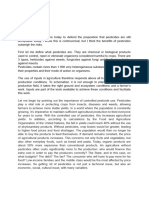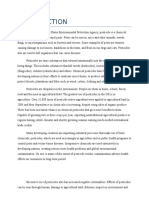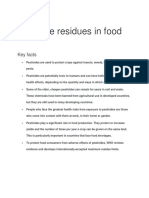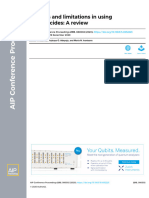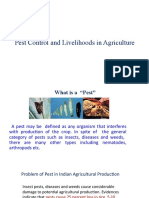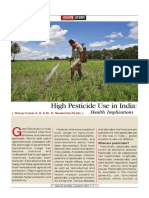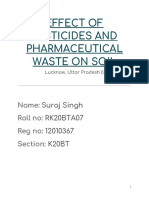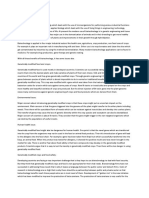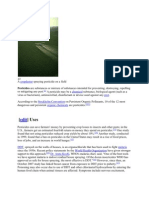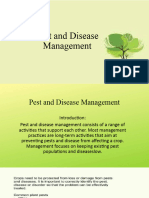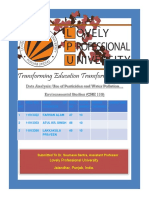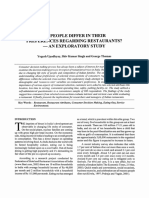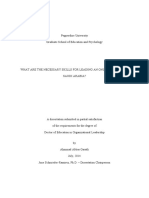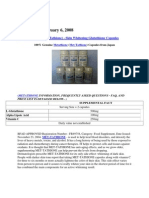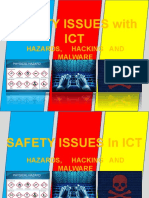0 ratings0% found this document useful (0 votes)
10 viewsCheproject
Cheproject
Uploaded by
Asmee JahanThe document discusses alternative pesticides that can be used in Bangladesh, noting that while pesticides increase crop yields, they can negatively impact human health and the environment long-term. It proposes biological and organic alternatives like crop rotation, polyculture, and pheromones that aim to control pests effectively while reducing harmful side effects. The conclusion advocates for integrated pest management approaches as proven alternatives to conventional pesticide use.
Copyright:
© All Rights Reserved
Available Formats
Download as PPTX, PDF, TXT or read online from Scribd
Cheproject
Cheproject
Uploaded by
Asmee Jahan0 ratings0% found this document useful (0 votes)
10 views10 pagesThe document discusses alternative pesticides that can be used in Bangladesh, noting that while pesticides increase crop yields, they can negatively impact human health and the environment long-term. It proposes biological and organic alternatives like crop rotation, polyculture, and pheromones that aim to control pests effectively while reducing harmful side effects. The conclusion advocates for integrated pest management approaches as proven alternatives to conventional pesticide use.
Original Title
cheproject
Copyright
© © All Rights Reserved
Available Formats
PPTX, PDF, TXT or read online from Scribd
Share this document
Did you find this document useful?
Is this content inappropriate?
The document discusses alternative pesticides that can be used in Bangladesh, noting that while pesticides increase crop yields, they can negatively impact human health and the environment long-term. It proposes biological and organic alternatives like crop rotation, polyculture, and pheromones that aim to control pests effectively while reducing harmful side effects. The conclusion advocates for integrated pest management approaches as proven alternatives to conventional pesticide use.
Copyright:
© All Rights Reserved
Available Formats
Download as PPTX, PDF, TXT or read online from Scribd
Download as pptx, pdf, or txt
0 ratings0% found this document useful (0 votes)
10 views10 pagesCheproject
Cheproject
Uploaded by
Asmee JahanThe document discusses alternative pesticides that can be used in Bangladesh, noting that while pesticides increase crop yields, they can negatively impact human health and the environment long-term. It proposes biological and organic alternatives like crop rotation, polyculture, and pheromones that aim to control pests effectively while reducing harmful side effects. The conclusion advocates for integrated pest management approaches as proven alternatives to conventional pesticide use.
Copyright:
© All Rights Reserved
Available Formats
Download as PPTX, PDF, TXT or read online from Scribd
Download as pptx, pdf, or txt
You are on page 1of 10
ALTERNATIVE PESTICIDES IN
BANGLADESH
Group members:
Name ID
1. Ummay Humayra Papiya 1520425
2. Asmee Jahan 1521608
3. Md. Mashur-Ul-Islam 1530730
Introduction
“PESTICIDES” are the substances
meant for attracting, seducing, and
then destroying, or mitigating any
pest. They are a class of biocide. The
most common use of “Pesticides” is
as plant protection products, which
in general protect plants from
damaging influences such as weeds,
plants diseases or insects. Here we
have to discuss about alternatives of
pesticide which can be biological,
organic etc.
Facts about Pesticides
Pesticides Increase Suicide Risk among Farmers?
Pesticides Are Affecting Pregnant Women
Pesticide Regulations Are a Joke
Pesticides Are Killing the Bees
Pesticides Have Contaminated Our Food
Pesticides Are Polluting the Air
We Don’t Fully Understand the Devastating Effect of
Pesticides
Some More Facts
At least three million people are
poisoned by pesticides every
year.
25 million agricultural workers
are poisoned every year.
More than 200,000 people die
each year from pesticides.
Half of all pesticides are used on
the five main crops- cereal,
corn/maize, rice, cotton, soya.
Goals of using Alternative Pesticide
Pesticides are mostly harmful in the long run. Therefore, the main
objective of using the alternatives is to reduce the side effects.
Here the alternatives would be such effective that it will totally
fulfill the necessity of use of the pesticides which we are using
these days. Moreover, taking some additional benefits from the
alternatives.
Methods
Crop rotation.
Polyculture.
Trap crops, which attract pests away from the valuable crops.
Reduced use of chemical pesticides.
Organic farming.
Biological pest control, such as:
Pheromones.
Entomopathogenic fungi.
Bacteria and viruses.
The release of other organisms, such as natural pest predators and parasites.
Genetic engineering practices, such as insect breeding interference.
Advantages
Increase food production – Crop protection technologies allow U.S.
producers to increase crop yields and efficiency of food production
processes. Up to 40 percent of the world's potential crop production is
already lost annually because of the effects of weeds, pests and diseases.
These crop losses would be doubled if existing pesticide uses were
abandoned.
Decrease the cost of food – Because the use of pesticides improves crop
yields, crop protection technologies also impact the cost of food. Without
crop protection chemicals, food production would decline, many fruits and
vegetables would be in short supply and prices would rise. Helping to keep
food prices in check for the consumer is another large benefit of pesticides.
Consumer benefits – Pesticides allow consumers to consume high-quality
produce that is free of insect blemishes and insect contamination. Crop
protection chemicals that reduce and, in some cases, eliminate, insect
damage allow the consumer to purchase high-quality produce free of insect
fragments.
Disadvantages
Health effects- Pesticides may cause acute and delayed health effects in people
who are exposed. Pesticide exposure can cause a variety of adverse health
effects, ranging from simple irritation of the skin and eyes to more severe
effects such as affecting the nervous system, mimicking hormones causing
reproductive problems, and also causing cancer.
Environmental effect- Pesticide use raises a number of environmental
concerns. Over 98% of sprayed insecticides and 95% of herbicides reach a
destination other than their target species, including non-target species, air,
water and soil. Pesticide drift occurs when pesticides suspended in the air as
particles are carried by wind to other areas, potentially contaminating them.
Pesticides are one of the causes of water pollution, and some pesticides
are persistent organic pollutants and contribute to soil contamination.
Economics- Human health and environmental cost from pesticides in the
United States is estimated at $9.6 billion offset by about $40 billion in
increased agricultural production.
Additional costs include the registration process and the cost of purchasing
pesticides. The registration process can take several years to complete (there
are 70 different types of field test) and can cost $50–70 million for a single
pesticide. Annually the United States spends $10 billion on pesticides.
Observations & results
Using the alternatives of pesticides is being highly beneficial
these days. Although there are some merits of using pesticides
which we have already mentioned in the long run it’s proven
that pesticides are mostly harmful. By using the alternatives we
getting the advantages of using the pesticides moreover we are
getting some additional benefits.
Conclusion
There are proven alternatives to conventional pesticide use. These
approaches consider pest problems within a broad context that
considers many factors and also call for determining if pests are
actually causing or are likely to cause damage to health or crops,
and, if they are, whether the extent of damage warrants action.
You might also like
- Cancer - My Chemical RomanceDocument5 pagesCancer - My Chemical Romancebendarwish100% (5)
- Marketing Budget 2022 (KMED)Document8 pagesMarketing Budget 2022 (KMED)AJ SinambanNo ratings yet
- ASEAN SCOUT ON REGIONAL COOPERATION-ASARC DocNo.4a ConstitutionDocument10 pagesASEAN SCOUT ON REGIONAL COOPERATION-ASARC DocNo.4a ConstitutionAri Wijanarko Adipratomo, A.A.No ratings yet
- Pesticide ResiudeDocument6 pagesPesticide ResiudeNamra ImranNo ratings yet
- Débat Anglais 1Document3 pagesDébat Anglais 1Raphanel NoemieNo ratings yet
- Pesticides - Future Prospects of Biopesticides: Department of Chemical EngineeringDocument17 pagesPesticides - Future Prospects of Biopesticides: Department of Chemical EngineeringSahil ParateNo ratings yet
- Advantages and Disadvantages of AgrochemicalsDocument3 pagesAdvantages and Disadvantages of Agrochemicalsmldc200667% (3)
- safanafffDocument36 pagessafanafffsafa yazaNo ratings yet
- TopicDocument2 pagesTopicTimotheé KensukeNo ratings yet
- Biopestisides in Ipm 1Document21 pagesBiopestisides in Ipm 1sachinNo ratings yet
- Chapter 3Document33 pagesChapter 3Anonymous d0kgwnjmQbNo ratings yet
- chem shreyashDocument25 pageschem shreyashShreyash ThamkeNo ratings yet
- KartikDocument4 pagesKartikkartikNo ratings yet
- Bio PesticidesDocument15 pagesBio PesticidesDevrajNo ratings yet
- CONTENTSDocument21 pagesCONTENTSItachi UchihaNo ratings yet
- Advantages and Limitations of Biofertilizers and Biological ControlDocument4 pagesAdvantages and Limitations of Biofertilizers and Biological Controlyaqoob008No ratings yet
- The International Journal of Engineering and Science (The IJES)Document8 pagesThe International Journal of Engineering and Science (The IJES)theijesNo ratings yet
- Assigment Pesticides (FULL)Document13 pagesAssigment Pesticides (FULL)Yana NanaNo ratings yet
- Paoletti-Pimentel2000 Article EnvironmentalRisksOfPesticidesDocument26 pagesPaoletti-Pimentel2000 Article EnvironmentalRisksOfPesticidesAida FitriyahNo ratings yet
- " Crop Protection" Pesticide UseDocument25 pages" Crop Protection" Pesticide UseEthyle Morales LingbawanNo ratings yet
- Agriculture AssignmentDocument6 pagesAgriculture AssignmentJames MuturiNo ratings yet
- Bio PesticidesDocument15 pagesBio PesticidesSangram PandaNo ratings yet
- Reshma ChemistryDocument14 pagesReshma ChemistryHridya UllasNo ratings yet
- Bl3205 Biological Risk Management: Pesticide Pops (Persistent Organic Pollutants) and Ipm AlternativesDocument16 pagesBl3205 Biological Risk Management: Pesticide Pops (Persistent Organic Pollutants) and Ipm Alternativesredapple26No ratings yet
- Chemistry ProjectDocument22 pagesChemistry Projectamudhansivakumar145No ratings yet
- Use of ChemicalsDocument50 pagesUse of ChemicalsTaraka nadh Nanduri100% (1)
- Pesticide Residues in Food: Key FactsDocument5 pagesPesticide Residues in Food: Key FactsahmedaliNo ratings yet
- (2020) Benefits and Limitations in Using Biopesticides a ReviewDocument7 pages(2020) Benefits and Limitations in Using Biopesticides a ReviewPHONG LÊ TẤNNo ratings yet
- Agro Based II Pest ControlDocument71 pagesAgro Based II Pest ControlAtom CarbonNo ratings yet
- Project ResearchDocument18 pagesProject ResearchhenjiegawiranNo ratings yet
- High Pesticide Use in India Health Implications - Health Action August 2017 1Document6 pagesHigh Pesticide Use in India Health Implications - Health Action August 2017 1Yashasvi SharmaNo ratings yet
- Environment and Health Aspects of Pesticides Use in Indian AgricultureDocument21 pagesEnvironment and Health Aspects of Pesticides Use in Indian AgricultureNaveen KumarNo ratings yet
- Challenges and Options of Pesticide Use - in The Context of NepalDocument12 pagesChallenges and Options of Pesticide Use - in The Context of NepalRaj K Adhikari0% (1)
- Importance of BiopesticidesDocument6 pagesImportance of Biopesticidesshyamsunder68100% (1)
- Chemistry ProjectDocument22 pagesChemistry ProjectSneha SatapathyNo ratings yet
- Effect of Pesticides and Pharmaceutical Waste On SoilDocument13 pagesEffect of Pesticides and Pharmaceutical Waste On SoilSuraj SinghNo ratings yet
- Effect of Pesticides On Environment: 1. AbstractDocument7 pagesEffect of Pesticides On Environment: 1. AbstractPdisk LinksNo ratings yet
- Chemistry ProjectDocument22 pagesChemistry Projectamudhansivakumar145No ratings yet
- Biotechnollogy Debate ArgumentsDocument2 pagesBiotechnollogy Debate ArgumentsDaniel villabNo ratings yet
- Issues in BiotechnologyDocument5 pagesIssues in Biotechnologymaricar baculoNo ratings yet
- Pest ControlDocument1 pagePest ControlErdem EzerNo ratings yet
- Pest ManagementDocument45 pagesPest ManagementRommel SacramentoNo ratings yet
- Chemistry ProjectDocument13 pagesChemistry Projectlekodaj294No ratings yet
- Study of Presence of Insecticides and Pesticides in Fruits and VegetablesDocument21 pagesStudy of Presence of Insecticides and Pesticides in Fruits and VegetablesgoldlinshruthiNo ratings yet
- Agricultural Biology 3Document14 pagesAgricultural Biology 3ayobami0aduraNo ratings yet
- Homecillo SoberanoDocument35 pagesHomecillo SoberanoBangtan ArmyNo ratings yet
- Class 12 Biology AgrochemicalDocument40 pagesClass 12 Biology AgrochemicalShannavi ChakrabortyNo ratings yet
- Bio PesticidesDocument8 pagesBio Pesticidestulip679No ratings yet
- Pesticides and Their Residue in IndiaDocument2 pagesPesticides and Their Residue in IndiaBhavesh YadavNo ratings yet
- Pesticide Industry-An OverviewDocument18 pagesPesticide Industry-An OverviewFaiz Ahmad100% (1)
- Bio ProjDocument8 pagesBio ProjKeerthi SanthoshNo ratings yet
- Health PesticideDocument8 pagesHealth PesticideKejora HanadinantiNo ratings yet
- Environmental Science - 1Document11 pagesEnvironmental Science - 1Rana HussnainNo ratings yet
- Agro-Chemical ExamDocument14 pagesAgro-Chemical ExamFS MBNo ratings yet
- Tech Rep Org PestDocument18 pagesTech Rep Org Pest2401102163No ratings yet
- Herbicides - Advantages and Limitation of Herbicide Usage in IndiaDocument4 pagesHerbicides - Advantages and Limitation of Herbicide Usage in IndiaYaswanth NaikNo ratings yet
- Bio PesticideDocument10 pagesBio PesticideDeepak KesharwaniNo ratings yet
- EkfhkdhvfkDocument4 pagesEkfhkdhvfkMinett CabaccanNo ratings yet
- Pest and Disease ManagementDocument20 pagesPest and Disease ManagementicpmurciaemhcNo ratings yet
- Report On Pesticides and Water PollutionDocument25 pagesReport On Pesticides and Water PollutionAtul SinghNo ratings yet
- Pesticides in Agriculture and Environment: Impacts On Human HealthDocument20 pagesPesticides in Agriculture and Environment: Impacts On Human HealthSushanta BeheraNo ratings yet
- Ojsadmin,+8 +Effective+Mass+Production+TechniqueDocument5 pagesOjsadmin,+8 +Effective+Mass+Production+TechniquePalak AgarwalNo ratings yet
- Business Law Assignment FinalDocument13 pagesBusiness Law Assignment FinalAsmee JahanNo ratings yet
- Spatial Vulnerability Assessment of Extreme Lightning Events in Bangladesh Using GIS M. A. Farukh, S. U. Ahmed, M. A. Islam and M. A. BatenDocument8 pagesSpatial Vulnerability Assessment of Extreme Lightning Events in Bangladesh Using GIS M. A. Farukh, S. U. Ahmed, M. A. Islam and M. A. BatenAsmee JahanNo ratings yet
- 10 5923 J Arch 20211101 02Document11 pages10 5923 J Arch 20211101 02Asmee JahanNo ratings yet
- Do People Differ in Their Preferences Regarding Restaurants? - An Exploratory StudyDocument17 pagesDo People Differ in Their Preferences Regarding Restaurants? - An Exploratory StudyAsmee JahanNo ratings yet
- Fire Risk Situation Analysis in The Nimtoli Area of Old DhakaDocument13 pagesFire Risk Situation Analysis in The Nimtoli Area of Old DhakaAsmee JahanNo ratings yet
- So SoDocument31 pagesSo SoAsmee JahanNo ratings yet
- What Are The Necessary SkillsDocument163 pagesWhat Are The Necessary SkillsAsmee JahanNo ratings yet
- "Sun Chips": Report OnDocument13 pages"Sun Chips": Report OnAsmee JahanNo ratings yet
- Cv-Haji Msangi 2018Document4 pagesCv-Haji Msangi 2018fusslameckNo ratings yet
- CapsulesDocument6 pagesCapsulesdensity66No ratings yet
- LR LRV LLRDocument8 pagesLR LRV LLRAnonymous CMS3dL1TNo ratings yet
- TEXT of Novel Hard Times by Charles DickensDocument381 pagesTEXT of Novel Hard Times by Charles DickensHANI AHMEDNo ratings yet
- Unit 2 BFE FINALDocument25 pagesUnit 2 BFE FINALezekiel davidNo ratings yet
- Daddy Babygirl Hike Part 1Document1 pageDaddy Babygirl Hike Part 1Paul WalterNo ratings yet
- Footing PDFDocument1 pageFooting PDFPom tancoNo ratings yet
- Isaac Bashevis Singers Yiddish Stories PDFDocument13 pagesIsaac Bashevis Singers Yiddish Stories PDFLina M.No ratings yet
- Mercedes RapportDocument137 pagesMercedes RapportFatima Ezzahra El MasbahiNo ratings yet
- Group 3 Safety Issues in ICTDocument15 pagesGroup 3 Safety Issues in ICTRoseAnnNo ratings yet
- Bayan TelDocument4 pagesBayan TelSi OneilNo ratings yet
- Hemavata SuttaDocument114 pagesHemavata Suttaanon7535No ratings yet
- Bol Rev TroubledEmpire BrookDocument5 pagesBol Rev TroubledEmpire BrookDewa AsmaraNo ratings yet
- CSS Worksheet: JMC 105 - Drake UniversityDocument7 pagesCSS Worksheet: JMC 105 - Drake UniversityJohn ZapantaNo ratings yet
- Donaldson, Bess Allen (1937) - Koran As MagicDocument12 pagesDonaldson, Bess Allen (1937) - Koran As MagicAndreaNo ratings yet
- Synthesis of Thyroid HormonesDocument1 pageSynthesis of Thyroid HormonesAndioNo ratings yet
- tài liệuDocument4 pagestài liệuPhước Thắng TốngNo ratings yet
- Building Blocks of TQMDocument34 pagesBuilding Blocks of TQMBalram Ji0% (2)
- Access2013 T02 PPTDocument43 pagesAccess2013 T02 PPTArshad AyubNo ratings yet
- module-4-PE-Health 3rdyearDocument10 pagesmodule-4-PE-Health 3rdyearAngelica SaczNo ratings yet
- Ghana Investment Promotion Centre (Gipc) Act 865Document19 pagesGhana Investment Promotion Centre (Gipc) Act 865JeffreyNo ratings yet
- Ipl - The New Marketing Cocktail: Submitted by - Sugandha Sharma Mba Ii SemDocument11 pagesIpl - The New Marketing Cocktail: Submitted by - Sugandha Sharma Mba Ii SemSugandha SharmaNo ratings yet
- Structure Equation Analysis On Customer Satisfaction of Public Transport: An Empirical Study in Klang Valley MalaysiaDocument5 pagesStructure Equation Analysis On Customer Satisfaction of Public Transport: An Empirical Study in Klang Valley Malaysiashakthi jayanthNo ratings yet
- Varmam RX For Musculo Skeletal DisorderDocument5 pagesVarmam RX For Musculo Skeletal DisorderYoga Naayak100% (1)
- King ApplicationDocument75 pagesKing ApplicationJenniferNo ratings yet
- Geothermal Powerplant (Binary Cycle)Document18 pagesGeothermal Powerplant (Binary Cycle)Lars Eric TabalnoNo ratings yet
- Introduction To MineralogyDocument12 pagesIntroduction To MineralogyBayari E EricNo ratings yet




